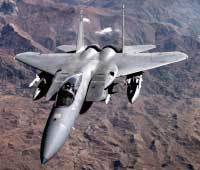|
 The
Missile Defense Agency will soon award Lockheed Martin
a $3 million contract to study the feasibility of equipping
F-15C fighters with Patriot Advanced Capability-3 missiles
to counter cruise missiles and intercept ballistic missiles
in their boost phase, according to agency and company
officials. The
Missile Defense Agency will soon award Lockheed Martin
a $3 million contract to study the feasibility of equipping
F-15C fighters with Patriot Advanced Capability-3 missiles
to counter cruise missiles and intercept ballistic missiles
in their boost phase, according to agency and company
officials.
The Air Launched Hit-to-Kill initiative
is focused on a “refined design” of an F-15C’s
external weapons bay with the PAC-3 Missile Segment
Enhancement integration and performance estimate, an
MDA official wrote in a Dec. 21 e-mail to Inside the
Army.
MDA is expected to award Lockheed the
money in the “next few days” for risk reduction
and concept definition, according to the agency official.
Mike Trotsky, Lockheed Martin vice president
of Air and Missile Defense programs, told ITA Dec. 6
that equipping a fighter with the missile capability
would be beneficial for two reasons -- it could defeat
cruise missiles and intercept ballistic missiles in
their boost phase.
“If a Scud was launched from a
barge or if a cruise missile was launched outside territorial
waters attacking the United States, obviously if you
had an F-15 up and it had a PAC-3 on it you could do
long-range cruise missile defense or [tactical ballistic
missile] defense,” Trotsky explained.
He said there are two feasible concepts
for employing the weapon.

First, fighters equipped with PAC-3
missiles (above) could be assigned to fly routine Civil
Air Patrol. In the second scenario, the Defense Department
could “scramble” PAC-3 equipped fighters as
needed, Trotsky explained.
 Lockheed
calls the PAC-3 MSE, the baseline missile for the Medium
Extended Air Defense System, a more powerful version
of its hit-to-kill missile now in production. Lockheed
calls the PAC-3 MSE, the baseline missile for the Medium
Extended Air Defense System, a more powerful version
of its hit-to-kill missile now in production.
“The MSE uses a more powerful rocket
motor and larger fins for increased maneuverability
against faster, more sophisticated ballistic and cruise
missiles targets,” Jennifer Allen, a company spokeswoman,
told ITA in July. “With an extended reach of up
to 50 percent with MSE, MEADS would gain even more capability
to protect ground forces and vital assets.”
Next year, MSE will fly during a control
test without a target and two flight tests with targets.
Following testing, the Army is expected to make a production
decision, Trotsky said earlier this month.
The Navy has also studied the feasibility
of fighter aircraft equipped with PAC-3 missiles, as
InsideDefense.com reported in May 2005.
In addition to MDA’s funding of
the Air Launched Hit-to-Kill effort, the agency has
advanced a $2 million proposal for Lockheed Martin to
build an Infrared Search and Tracking System (IRSTS),
which would be used with the Air Launched Hit-to-Kill
technology, an MDA official said. The agency has requested
the funding via the director of defense research and
engineering’s Quick Reaction Special Projects program.
A decision on this initiative is expected late next
month, MDA said.
The IRSTS would have utility for both
the Air Launched Hit-to-Kill effort as well as another
initiative known as the Net Centric Airborne Defense
Element, the MDA official said.
“Unfortunately, the IRSTS will
arrive too late to support the first proposed Net Centric
Airborne Defense Element (NCADE) flight test later this
year,” the MDA official wrote. “NCADE, another
air-launched concept under contract with Raytheon, utilizes
major components from existing air-to-air missiles.
The initial NCADE flight test will likely take place
this summer on the White Sands Missile Range, with the
objective of verifying the NCADE seeker’s capability
of differentiating plume from hard body in a boost-phase
intercept.”
Additionally, the official said the
NCADE flight test will be supported by the Air Force
Seek Eagle office, and either the Air National Guard/Air
Force Reserve Test Center in Tucson, AZ, or the 46 Test
Group at Holloman Air Force base, NM. |